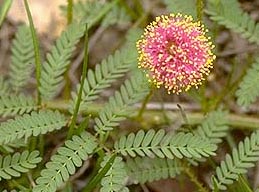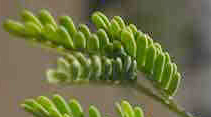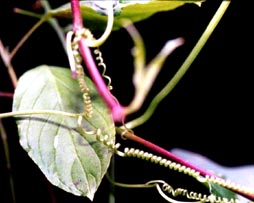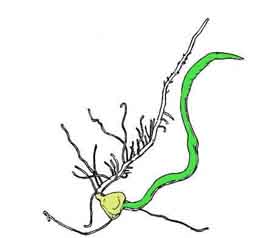| |
Plants move by osmotic changes and
differential growth. |
| Rapid movements such as closing leaves
involve changes in the turgor pressure
in cells |
 |
 |
|
| |
|
Other plant movements are due to differential
growth. Auxin produced at the tip flows down with gravity
and causes growth in the next cells. Auxin regulates the rate
at which a cell absorbs water and expands as well as regulating
division of the meristmatic cells. |
| Leaves originate from the
shoot apical meristem, a small mound of undifferentiated
tissue at the tip of the stem. Leaf formation begins with
the selection of a group of founder cells in the so-called
peripheral zone at the flank of the meristem, followed by
the initiation of local growth and finally morphogenesis
of the resulting bulge into a differentiated leaf. Auxin
produced by the first leaf flow down and cause the second
leaf bud to grow, auxin from leaf 2 causes leaf 3 to grow
which in turn causes leaf 4 to grow. |
 |
|
| |
|
| Look below to see how the effects
of gravity and sunlight can result in differential growth. |
| |
|
A directional response
(tropism) is caused by differential growth. Growth
can be induced by light (phototrophism), gravity (gravitropism),
or touch (thigomotropism). |
Light receptors called cryptochromes
bind flavoproteins and cause auxin to move from the lighted
side of the stem to the darkened side, where it stimulates
cell elongation. From your experiments, to what color light
do cryptochromes respond? |
|
|
|
| The coils in this tendril are
the result of differential growth. |
 |
Corn seedlings grown in a apparatus that constantly
rotates.
C. L. Stong, "The Effects of Gravity
on Plant Growth." Scientific American, June 1970.
|
 |